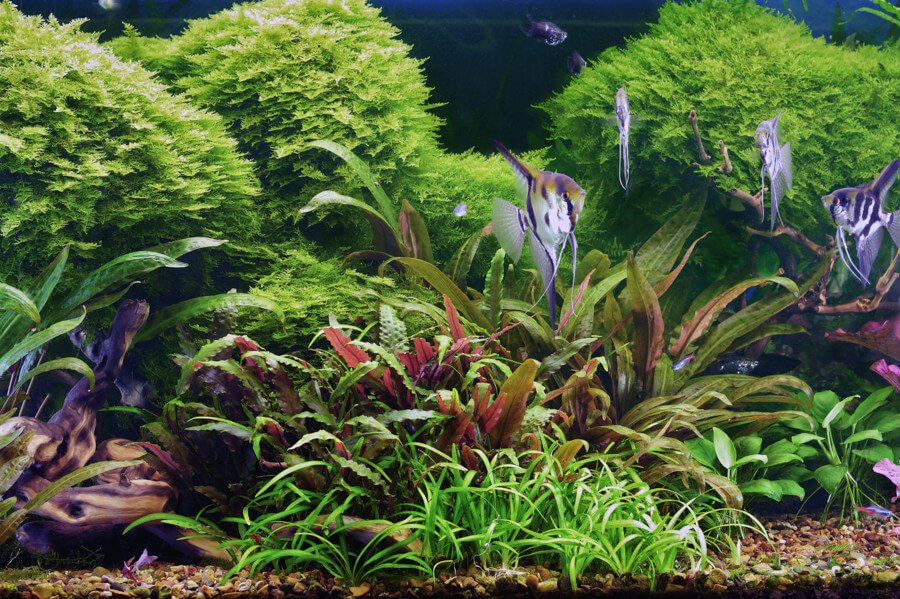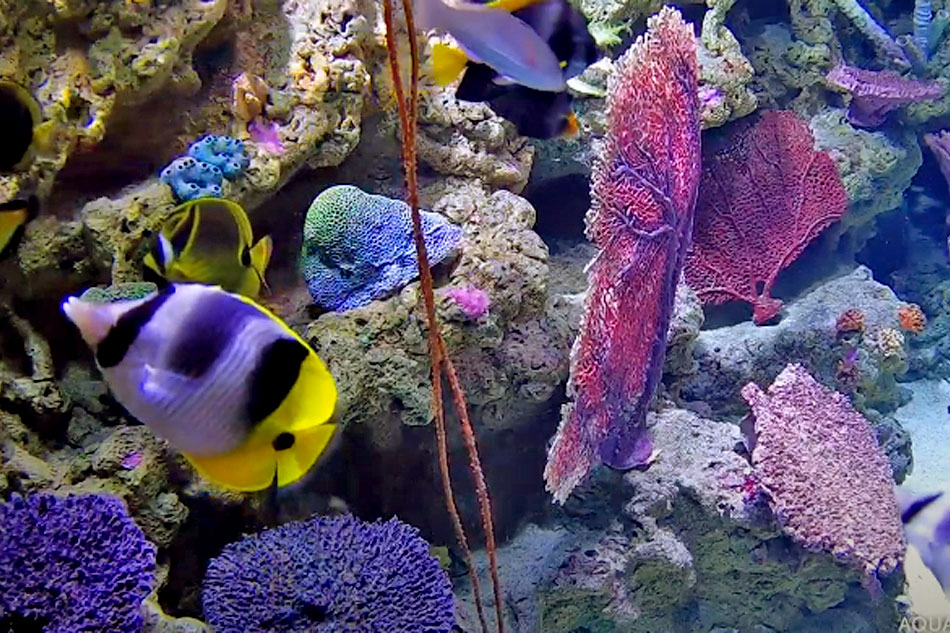Introduction: A Glimpse into the Watery Realm
Beneath the shimmering surface of a well-kept fish tank lies a microcosm teeming with life, an aquatic symphony where each organism plays its part in harmony. This underwater world, often enclosed within glass walls, is more than just a decorative piece; it’s a living ecosystem with complexities and wonders that mirror those found in Earth’s vast oceans. In this journey, we delve into the heart of a fish tank, unraveling the intricate balance of life that sustains these miniature habitats.
The Living Canvas: Aquarium Design Basics
The foundation of any thriving aquarium rests on its design. An ideal setup mimics nature, considering factors like water chemistry, temperature, lighting, and decor. Aquascaping, the art of arranging aquatic plants, rocks, and driftwood, not only enhances visual appeal but also provides essential hiding spots for shy inhabitants, mimicking their natural environment. The right combination fosters a balanced ecosystem where organisms coexist in harmony.

Water: The Essence of Life
Water, the lifeblood of the aquarium, demands meticulous attention. Maintaining optimal parameters—pH, hardness, ammonia, nitrite, and nitrate levels—is crucial. Regular water changes, typically 10-20% weekly, replenish vital minerals and dilute harmful substances. Employing a high-quality filtration system ensures continuous circulation, removing waste and promoting a healthy environment for all inhabitants.
Lighting the Depths: Balancing Act of Photosynthesis
Light, the energy source for photosynthetic organisms, plays a pivotal role. Planted aquariums require specialized lighting to support plant growth, which in turn generates oxygen through photosynthesis, benefiting fish and other fauna. Proper lighting schedules mimic day-night cycles, regulating biological rhythms and enhancing the aesthetic appeal of the tank.

Inhabitants: A Diverse Ensemble
Fish, the stars of the aquarium, come in a dazzling array of shapes, sizes, and temperaments. Selecting compatible species that thrive in similar conditions is paramount. Understanding their social behaviors, dietary needs, and territorial tendencies is crucial to prevent aggression and ensure their well-being. Alongside fish, invertebrates like shrimp and snails, and plants contribute to the biodiversity, creating a self-sustaining ecosystem.
Nutrition: Feeding the Aquatic Community
A balanced diet is vital for the health and longevity of aquarium inhabitants. Varied diets, tailored to each species’ requirements, promote vibrant colors and robust health. Overfeeding, however, can lead to water quality issues, as uneaten food decomposes, releasing toxins. Regular feeding schedules and careful portion control are key to maintaining a clean and healthy environment.

Maintenance: The Key to Longevity
Aquarium maintenance goes beyond daily feeding routines. Regular monitoring of water parameters, cleaning of filters, pruning of plants, and removal of debris are all integral parts of upkeep. Routine checks for signs of disease or distress in inhabitants allow for prompt intervention. It’s a labor of love that rewards aquarists with a thriving aquatic paradise.
The Cycle of Life: Nitrogen and the Aquatic Ecosystem
Understanding the nitrogen cycle is fundamental in aquarium keeping. This natural process involves converting toxic ammonia (from fish waste and uneaten food) into less harmful nitrite, and eventually into nitrate. Establishing a mature biological filter, which houses beneficial bacteria responsible for these conversions, is critical during the initial ‘cycling’ phase of a new aquarium. Mastery over this cycle ensures a stable and safe environment for all inhabitants.
Aquarium as an Educational Tool
Beyond aesthetics, aquariums serve as living classrooms, fostering curiosity and education about marine biology and ecology. They offer firsthand insights into aquatic life cycles, interdependence among species, and the importance of conservation efforts. For children and adults alike, aquariums inspire awe and deepen our understanding of the delicate balance of life on our planet.

Aquascaping Techniques: Crafting Visual Masterpieces Underwater
Beyond the basics of aquarium setup lies the art of aquascaping, a creative endeavor that transforms a fish tank into a stunning underwater landscape. Inspired by nature’s grandeur, aquascapers employ various techniques and styles to construct living works of art. This article explores some popular approaches to aquascaping, offering insights into how you can elevate your aquarium from functional to fantastic.
1. Dutch Style Aquascaping
Originating in the Netherlands, this classic style emphasizes dense groupings of diverse plants arranged in a structured, symmetrical layout. The Dutch style often features bright, contrasting colors and a clear distinction between foreground, midground, and background plants. Aquascapers in this tradition prioritize balance and order, creating a visually pleasing, garden-like appearance. To achieve this look, frequent pruning and fertilization are necessary to maintain the lush, manicured aesthetic.
2. Nature Aquarium (Iwagumi Style)
Developed by Takashi Amano, the Iwagumi style is a minimalist approach inspired by Japanese Zen gardens. Typically, it features a limited selection of plants, with emphasis on stone arrangement. The most common layout includes a focal point using a large rock (called ‘Oyaishi’), accompanied by smaller stones (‘Fukuishi’ and ‘Soeishi’). Aquatic plants are then used sparingly, often dominated by carpeting varieties at the foreground and tall stem plants towards the back. The Iwagumi style highlights simplicity, emphasizing natural beauty through subtle contrasts and a sense of flow.

3. Jungle Style
Contrasting the ordered Dutch style, jungle aquascapes mimic the wild, untamed essence of tropical rainforests. This approach encourages the use of a wide variety of plants, allowing them to grow freely and create a dense, lush environment. The lack of strict structure creates a naturalistic feel, with plants overlapping and intertwining. This style is particularly suitable for tanks housing fish that appreciate dense vegetation for hiding and breeding, such as cichlids or tetras.
4. Riparium Style
Riparium setups simulate the transition zone between land and water, incorporating elements from both habitats. This unique style often includes emergent plants that grow partially submerged and terrestrial plants positioned at the water’s edge. Ripariums may also feature driftwood, rocks, and occasionally even small land animals like frogs. This approach is perfect for those interested in replicating the ecotone found along riverbanks or lake shores, providing a diverse range of habitats within a single tank.
Conclusion: Embracing the Aquatic Symphony
An aquarium, when tended with care and understanding, becomes a mesmerizing window into the heart of aquatic life. It’s a testament to the intricate balance of nature, where every organism, from the tiniest microbe to the most vibrant fish, contributes to a harmonious ecosystem. By delving into the complexities of aquarium keeping, we not only create beautiful living art but also cultivate respect for the vast and wondrous aquatic realms that envelop our planet. Aquatic life, unveiled, reminds us of the interconnectedness of all life and the beauty in nurturing these delicate ecosystems.










